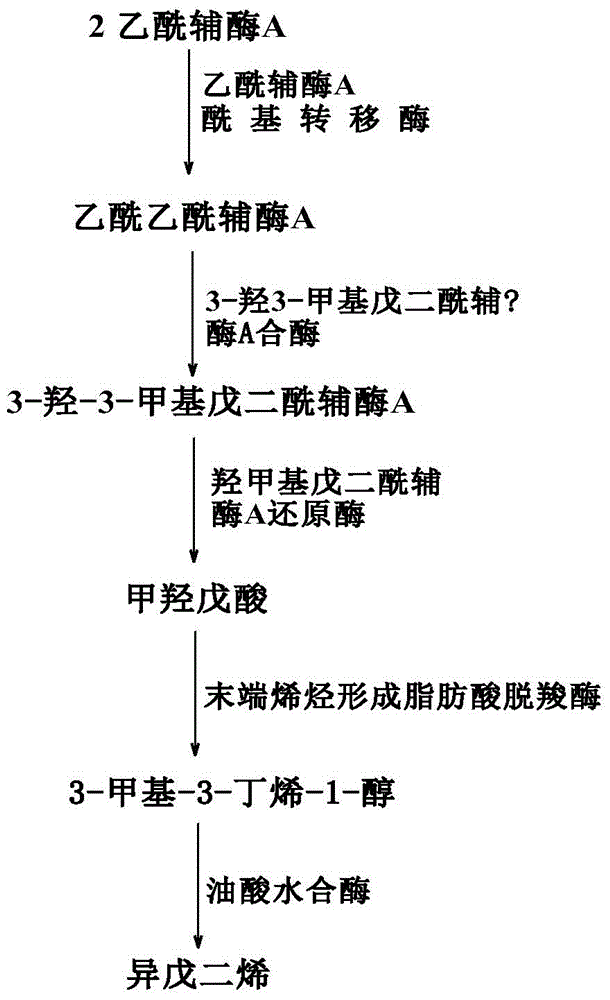A kind of isoprene-producing genetically engineered bacteria and its application
A genetically engineered bacteria and isoprene-producing technology, applied in the field of genetic engineering, can solve the problems of self-metabolism disorder of cells, affect the normal growth and metabolism of cells, etc., and achieve the effect of shortening the reaction process
- Summary
- Abstract
- Description
- Claims
- Application Information
AI Technical Summary
Problems solved by technology
Method used
Image
Examples
Embodiment 1
[0038] Example 1 Cloning of foreign gene and construction of expression vector
[0039] 1. Cloning of foreign genes
[0040] 1.1 Cloning of MVA upstream metabolic pathway genes of Enterococcus faecalis
[0041] The mvaS gene (GenBank No. AAG02439) and the mvaE gene (GenBank No. AAG02438) from Enterococcus faecalis were obtained by chemical synthesis from Shanghai Jierui Company. Afterwards, it was respectively connected with the vector pGH (purchased from Shanghai Jierui Bioengineering Co., Ltd.) to obtain pGH / mvaS and pGH / mvaE.
[0042] 1.2 Cloning of OleT, OhydEM gene
[0043] The OleT gene (GenBank No. ADW41779.1) from Jeotgalicoccus sp. ATCC8456 and the OhydEM gene (GenBank No. ACT54545.1) of Elizabethkingia meningoseptica were chemically synthesized by Shanghai Jierui Company, and were respectively linked into pGH vector to form pGH / OleT, pGH / OhydEM vector.
[0044] 2 Construction of expression vector
[0045] 2.1 pFHR-1 vector construction
[0046] The pGH-OleT and ...
Embodiment 2
[0051] The construction and fermentation culture of embodiment 2 recombinant strains
[0052] The constructed plasmids were transformed into E. coli competent cells, and the recombinant bacteria were fermented and cultured by shake flask fermentation. The fermentation products were characterized by gas chromatography-mass spectrometry (GC-MS) and gas chromatography (GC), respectively. and quantitative detection.
[0053] 2.1 Construction of recombinant strain of E.coli
[0054] The recombinant plasmids pFHR-2 (pCOLA-OleT-OhydEM) and pFHR-3 (pACY-mvaE-mvaS) were co-heat-shocked to transform E. coli BL21 (DE3) competent cells, and plated on chloramphenicol and kana The LB solid plate of mycin was screened by PCR to obtain positive clones, thereby obtaining the engineered Escherichia coli containing pFHR-2 and pFHR-3.
[0055] 2.2 Cultivation of engineered Escherichia coli
[0056] The activated engineered Escherichia coli were inoculated into the LB liquid culture medium cont...
Embodiment 3
[0059] The influence of embodiment 3 different fermentation conditions on the yield of recombinant bacteria
[0060] Different fermentation conditions, such as induction temperature, rotation speed, inducer concentration, nitrogen source, substrate concentration, medium pH value and composition ratio, etc., will affect the yield of fermentation product isoprene. The present invention detects the effects of different induction temperatures and inducer concentrations on the production of isoprene. The cultivation method was the same as that in Example 2, and GC was used to quantify the fermentation product.
[0061] GC detection conditions: The GC system adopts Shandong Lunan Ruihong SP-6890 gas chromatograph, the chromatographic column is HP-INNOWAXcolumn (25m×250μm×0.2μm), and the detector is FID detector; the temperature of the gasification chamber is 200 °C, and the detection The temperature of the apparatus was 230 °C, and the flow rate of the carrier gas was 1 ml / min. Co...
PUM
 Login to View More
Login to View More Abstract
Description
Claims
Application Information
 Login to View More
Login to View More - R&D
- Intellectual Property
- Life Sciences
- Materials
- Tech Scout
- Unparalleled Data Quality
- Higher Quality Content
- 60% Fewer Hallucinations
Browse by: Latest US Patents, China's latest patents, Technical Efficacy Thesaurus, Application Domain, Technology Topic, Popular Technical Reports.
© 2025 PatSnap. All rights reserved.Legal|Privacy policy|Modern Slavery Act Transparency Statement|Sitemap|About US| Contact US: help@patsnap.com



